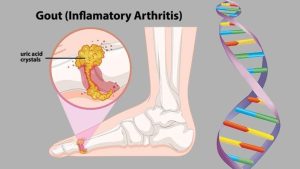Menopause is a necessary stage in every woman’s life. Due to the failure of ovarian function, it can bring a series of health problems, so let’s get to know menopause before we test ourselves.
What is menopause?
Menopause is a traditional name for the period of time before and after menopause, a special physiological stage when women transition from childbearing to old age, including the menopausal transition and early postmenopause. The essence of menopause is ovarian failure, which usually occurs after the age of 40. With the gradual decline of ovarian function, the number of follicles in the ovaries gradually decreases until they are depleted, resulting in a fluctuating decline in endogenous estrogen and progesterone, which leads to a variety of menopause-related symptoms, tissue atrophy and degeneration, and metabolic dysfunction, resulting in a series of physical and mental health problems.
What are the clinical manifestations of menopause?
Recent symptoms
Menstrual disorders: This is the first clinical manifestation of menopause, which is characterized by shortened and frequent menstrual cycles at first, and then gradually lengthened cycles until they stop, and some of them are characterized by irregular vaginal bleeding.
2. Vasodilatory symptoms: This is a characteristic symptom of lowered estrogen and is characterized by hot flashes and sweating. It is characterized by sudden bouts of redness on the face, neck and chest, accompanied by booming heat, followed by sweating, lasting from a few seconds to a few minutes. The symptoms can last 1-2 years, sometimes up to 5 years or longer, and can affect a woman’s work and life in severe cases.
3. autonomic dysregulation symptoms: often manifested as insomnia, palpitations, vertigo, tinnitus, abnormal skin sensation, etc.
4. Psychoneurotic symptoms: often manifest as high mood swings, anxiety, irritability, depression, low mood, lack of interest in the surrounding things, memory loss, etc. Serious cases need to be distinguished from neuropsychiatric diseases.
Long-term symptoms
1. Genitourinary syndrome of menopause (GSM): It is a collection of symptoms and signs of atrophy of the genital and urinary tracts and sexual dysfunction caused by reduced levels of estrogen and other sex hormones in women in the transitional and late menopausal periods, and is present in about half of menopausal women. The symptoms include dryness and burning sensation of vulva and vagina, sexual intercourse disorder, painful intercourse, recurrent vaginitis, recurrent urinary tract infections such as difficulty in urination, frequent and painful urination, coughing and leakage of urine and urinary incontinence.
2. Decreased bone mass and osteoporosis: Estrogen deficiency increases bone resorption, leading to rapid bone loss and osteoporosis, which occurs in more than half of women over 50 years old, with bone and joint pain, height shortening and easy fracture as the main clinical manifestations.
3. cardiovascular diseases: abnormal increase of blood glucose and lipid metabolism in postmenopausal women, fat redistribution, easy to develop abdominal obesity, atherosclerosis, coronary heart disease and other morbidity risks increase significantly.
4. cognitive dysfunction: postmenopausal women have a significantly higher risk of Alzheimer’s disease than men, which may be related to the lack of endogenous estrogen after menopause.
How can you tell if you are going through menopause?
It is now considered that women over 40 years of age who experience a change in the length of two adjacent menstrual cycles of ≥7 days within a 10-month period, for example, a period that normally occurs once every 28 days, and now occurs less than 21 days or more than once every 35 days, should consider that they may be going through menopause.
In other cases, women who have not reached the age of 40 may come to the hospital for examination and evaluation to see if the decline in ovarian function is the cause.
The third part of the population is some young women who have had their ovaries removed bilaterally because of other diseases such as malignant tumors or because of radiotherapy and other causes of ovarian function decline, which also fall into this category.


